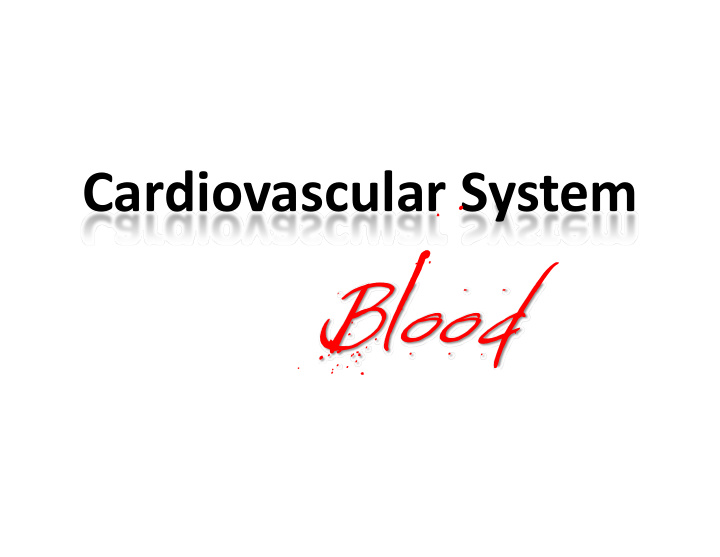



Cardiovascular System
Cardiovascular System • Components – Blood – Blood Vessels – Heart • General Functions – Transport – Regulation – Production/Synthesis – Movement – Protection
Blood • Why/How does blood flow? • Functions of blood – Carries respiratory gases, nutrients, and hormones – Helps body regulate temperature • Blood volume – Males: 5 ‐ 6 liters – Females: 4 ‐ 5 liters
Overview: Blood Composition • Connective Tissue • Contains cellular and liquid components – formed elements – plasma • Hematocrit – Males: • 47% ± 5% – Females: • 42% ± 5%
Blood Plasma • Straw ‐ colored, sticky fluid portion of blood • Approximately 90% water • Contains ions, nutrients, wastes, and proteins – Three main proteins • Albumin, globulins, and fibrinogen
Formed Elements • Blood cells – Erythrocytes (erythros = red, kytos (now cyte) = hollow cell) – Leukocytes (leukos = white) – Thrombocytes (thrombus = clot)
Erythrocytes – Red Blood Cells (RBCs) • Oxygen ‐ transporting cells – 7.5 µm in diameter Why is the size important? • Most numerous of the formed elements – Females: 4.3–5.2 million cells/cubic millimeter – Males: 5.2–5.8 million cells/cubic millimeter • Have no organelles or nuclei – why?
Erythrocytes – Red Blood Cells (RBCs) • Respiratory Pigment: Hemoglobin • Biconcave shape – 30% more surface area Why is the shape important? Form rouleaux in capillaries… also disorder if appears in normal blood smear. • Live 100–120 days • Originate in the bone marrow – Production is called erythropoiesis
Hemoglobin 3 ‐ dimensional structure of hemoglobin. The four subunits are shown in red and yellow The heme groups in green.
Leukocytes – White Blood Cells (WBCs) • 4,800–11,000/cubic millimeter • Protect the body from infectious microorganisms • Function outside the bloodstream in loose connective tissue • Diapedesis – circulating leukocytes leave the capillaries • Two types of leukocyte – Granulocytes and agranulocytes
Granulocytes • 55 – 80% of WBC count • Contain multilobed nuclei – Granules that pick up stain • Color and nuclear shapes are identifying characteristics of granulocytes – Neutrophils – most numerous WBC • Light colored granular staining cytoplasm • Nucleus – has two to six lobes – Eosinophils – compose 1–4% of all WBCs • Typically bi ‐ lobed nucleus • Cytoplasmic granules stain darker orange/red color – Basophils – about 0.5% of all WBCs • Nucleus – usually two lobes • Granules stain dark blue/purple – Tends to obscure the nucleus
Agranulocytes • Lymphocytes – compose 20–45% of WBCs – Involved in immunity – Effective in fighting infectious organisms Act against a specific foreign molecule (antigen) – Morphology: • Nucleus – round & stains dark purple • Cytoplasm – appears free of stained granules • Size – only slightly larger than erythrocyte – Two main classes of lymphocyte • T cells – attack foreign cells directly • B cells – multiply to become plasma cells – Secrete antibodies
Agranulocytes • Monocytes – compose 4–8% of WBCs – The largest leukocytes – Nucleus – kidney shaped – Cytoplasm – free of stained granules… – Transform into macrophages • Phagocytic cells
Thrombocytes (Platelets) • Cell fragments – Break off from megakaryocytes • Function in clotting of blood – Contain granules in cytoplasm that are involved in hemostasis
Blood Cell Formation • Process is called hematopoiesis • 200+ billion new blood cells formed each day • Location is bone marrow in adults: – Red marrow – actively generates new blood cells • Remains in epiphyses, girdles, and axial skeleton – Yellow marrow – dormant • Located in the long bones of adults – Tissue framework for red marrow • Reticular connective tissue • Where does hematopoiesis take in the embryo/fetus?
Hematopoiesis All blood cells originate in bone marrow • All originate from one cell type, the • hemocytoblast (pluripotential hematopoietic stem cell) Hemocytoblast differentiates into • A. Lymphoid stem cells give rise to lymphocytes – B. Myeloid stem cells give rise to all other blood cells –
Hematopoiesis cont… • Genesis of erythrocytes – Committed cells are proerythroblasts – Remain in the reticulocyte stage for 1–2 days in circulation – Make up about 1–2% of all erythrocytes • Formation of leukocytes – Granulocytes form from myeloblasts – Monoblasts enlarge and form monocytes • Platelet ‐ forming cells from megakaryoblasts – Break apart into platelets
Disorders of the Blood • Disorders of erythrocytes – Polycythemia – abnormal excess of erythrocytes – Anemia – erythrocyte levels or hemoglobin concentrations are low resulting in? – Sickle cell disease – inherited condition • Results from a defective hemoglobin molecule • Erythrocytes distort into a sickle shape
Disorders of the Blood • Disorders of leukocytes – Leukemia – a form of cancer – Classified as lymphoblastic or myeloblastic • Disorders of platelets – Thrombocytopenia • Abnormally low concentration of platelets
Early Hematopoeisis • Blood cells start to develop within the yolk sac during the first weeks • Late in the second month stem cells migrate from yolk sac to the liver and spleen – Take over until around month 7 • Bone marrow becomes major hematopoietic organ at month 7
Recommend
More recommend